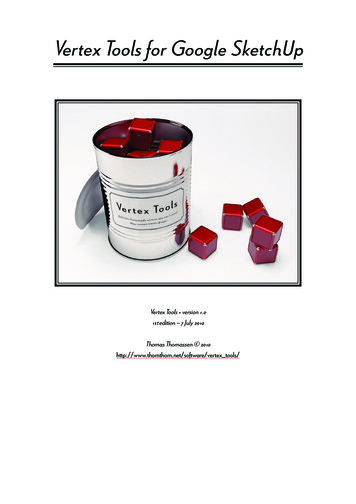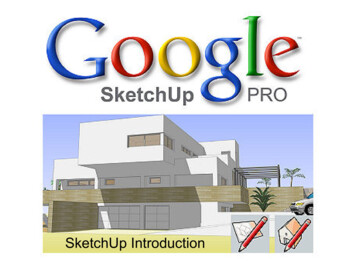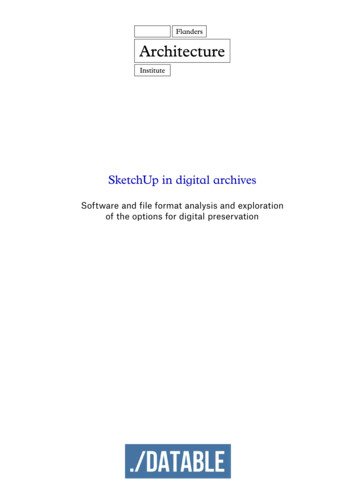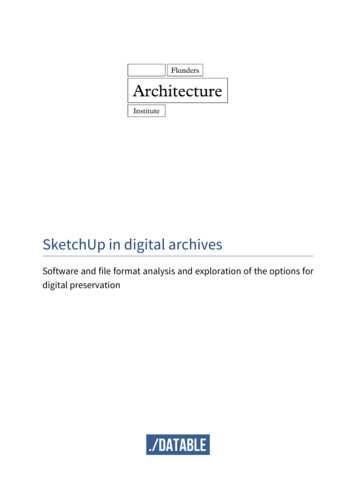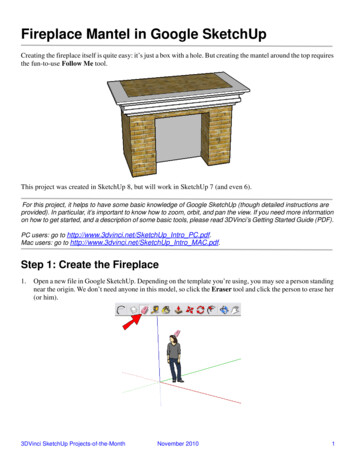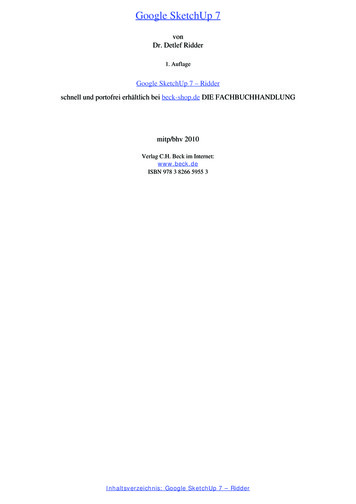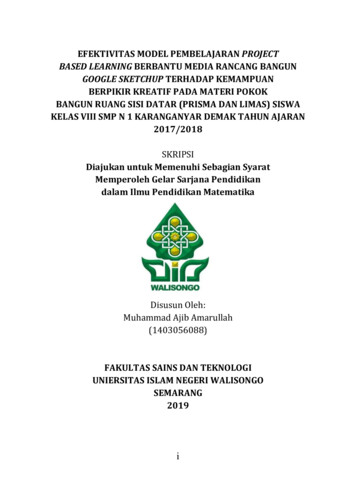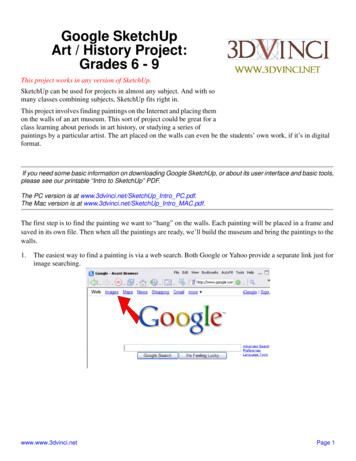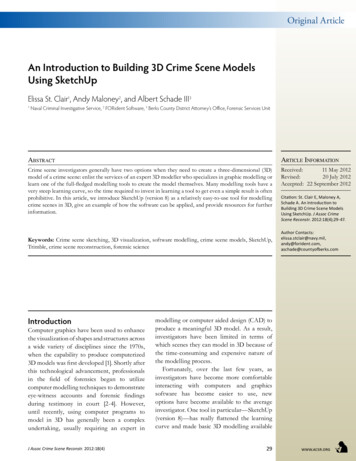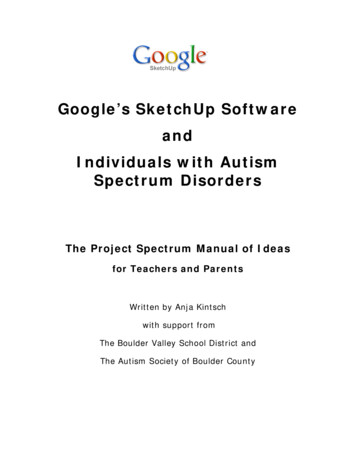
Transcription
Google’s SketchUp SoftwareandIndividuals with AutismSpectrum DisordersThe Project Spectrum Manual of Ideasfor Teachers and ParentsWritten by Anja Kintschwith support fromThe Boulder Valley School District andThe Autism Society of Boulder County
What is SketchUp?SketchUp software was originally designed for professional architects. It is adeceptively simple, powerful tool for creating, visualizing, and communicating ideasin 3D. SketchUp was developed to combine the elegance and spontaneity of pencilsketching with the speed and flexibility of today's digital media.Design software has been around for decades and is clearly here to stay. SketchUp isbeing put to good use by everyone from industry giants creating skyscrapers andfootball stadiums to elementary school kids using SketchUp to learn about shapes.It is also being successfully used by individuals with autism spectrum disorders.SketchUp offers individuals an alternative to handwriting when expressing theirknowledge, a possible vocational tool, and a way to virtually interact with new andchallenging environments before having to face them in person.What are Autism Spectrum Disorders?While ranging widely in its severity, autism affects individuals’ communication skillsand ability to deal with social interactions. People on the spectrum show difficulties inverbal and non-verbal communication, social interactions, and leisure or playactivities. They may display repetitive behaviors, show resistance to changes in dailyroutine, and can have unusual responses to sensory experiences, such as certainsounds or the way an object looks. Symptoms can be mild to severe. Those withautism may also have developmental delays and be non-verbal, while thosediagnosed with Asperger’s syndrome (or ‘high functioning autism’) have normalintelligence and are verbal.Many individuals, even those with “high functioning autism”, struggle with thephysical task of writing. They may possess a good understanding of the concepts butare unable to express them through traditional linguistic modes. Often they candemonstrate their knowledge by drawing, building or using some other method thatdoes not involve writing. Because of difficulties with social interactions and writing,many individuals with autism spectrum disorders (ASD) are drawn to areas such asmathematics, science and computers.The Project Spectrum StoryThe SketchUp team at Google receives thousands of emails from customers aroundthe world. A couple of years ago, the team noticed that a surprising number of theseemails were from parents who were using SketchUp in their professional lives, butwho wrote to tell how much their children with autism were using and enjoyingSketchUp.The SketchUp team soon came to understand that people with ASD tend to think andlearn visually, and that many autistic children are spatially and visually gifted. Sincethere was a clear connection between kids on the autism spectrum and SketchUp itseemed natural to explore whether SketchUp could provide these kids a creativeoutlet or possibly a life skill. Based on the positive response from the local autismcommunity, Google decided to formalize Project Spectrum in an effort to make
SketchUp and related learning materials more widely available to the ASDcommunity.The ManualThis manual is designed to help teachers, parents and others working with childrenwith ASD use the SketchUp program in a variety of creative ways. SketchUp can beused as a powerful tool for social explorations and as an alternative to writing todemonstrate knowledge. And because SketchUp is a relatively easy-to-use program,it is a good place for students interested in computer graphics to begin to exploretheir talents. The manual provides several examples from which one may begin, butthe possibilities are limitless.This manual is a list of exercises that can be done in SketchUp. Additionally, ideasfor using these lessons with Google Earth are included in some examples. ForSketchUp tutorials please see http://sketchup.google.com/sptutorials.html.The AuthorAnja Kintsch is the Assistive Technology Team Leader for the Boulder Valley SchoolDistrict working with students with a variety of disabilities. She is also a researcheron the Cognitive Levers Grant developing technology for individuals with cognitivedisabilities in the Center for LifeLong Learning and Design.Center for LifeLong Learning and Design (L3D)The Center for LifeLong Learning and Design (L3D) is an educational and researchunit of the Computer Science Department whose mission is the ongoing developmentof theory and technology to support learning, design, and communication. TheCenter's approach includes the development of conceptual frameworks andcomputational artifacts, as well as the cultivation of an understanding of their socialand organizational contexts. To this end, the Center conducts research and createslearning opportunities in collaboration with other academic, research, and industrialpartners at the University of Colorado, across Colorado, nationally, andinternationally, to develop innovative educational models to prepare learners andworkers for the challenges of the twenty-first century.
Downloads:Google oogle Earth: http://earth.google.com/Prerequisite Skills Include Must be able to use a 3-button mouse with accuracy. Must be able to read and follow simple step by step instructions. Must be willing to make mistakes – that’s part of the creative process!Sections1.Social Explorations2.Presentation of Knowledge3.Creativity
Section 1Social ExplorationsMost individuals with ASD have difficulty learning how to engage in the give and takeof everyday human interactions. They often have trouble seeing things from anotherperson's perspective and may not realize that others have their own thoughts,feelings, intentions, and points of view. Subtle social cues such as a smile, frown or agroan may hold little meaning. Without the ability to interpret gestures and facialexpressions, the social world may seem bewildering, and make predicting whatothers may say or do in social situations challenging. The unpredictability of theworld can be overwhelming and anxiety provoking particularly when in an unfamiliarenvironment. This can lead to a loss of emotional control or further isolation (NIMH,2007).Social stories or scripts are commonly used to aid people with ASD gain anunderstanding of the thoughts and feelings of others and the social rules that governour daily interactions. A specific social situation is described in detail and focus isgiven to a few key points: the important social cues, the events the individual mightexpect to occur in the situation, the actions and reactions that might be expected,and why. The goal of the story is to increase the individual’s understanding andcomfort, and possibly suggest some appropriate responses for the situation inquestion (Polyxo, 2007).Not only do individuals with ASD tend to dislike having their routines changed, manyare anxious of new environments where they are unsure of what to expect. Noises,sounds, and a variety of activities happening at once can be overwhelming. Astrategy many teachers and parents have used to help reduce this anxiety is todiscuss and show pictures of the new environment they will be visiting. UsingSketchUp, individuals can help create and explore the upcoming environment in amore complex and personalized fashion. Students can either use the scenes createdby others or develop their own.
Activity 1: Exploring EmotionsExplanation:Not only is reading the messages that are communicated by physical means (i.e.gestures, and facial expressions) challenging, but knowing why these feelings arebeing expressed is equally difficult. Direct instruction in this area can be helpful. Inthis lesson, individuals should identify different facial expressions and pair the eventsthat might cause the different reactions.Example:Grandpa and childNurseStanding girlFurther ideas: Comparing and contrasting faces. Match body language tofacial expressions.
Activity 2: Going to the GameExplanation:High school football games, track meets and other athletic competitions are animportant part of many students’ lives. However, competitions have rules not onlyfor the players but for the spectators as well. By exploring a football stadium,basketball court or other sporting venue, an individual can learn where they can go(e.g., not on the field or not on the opposing team’s side), where the best seats are,where they can find restrooms and concession stands. The can also explore theaspects that may be anxiety provoking such as the bright lights, speakers, or wherelarge crowds gather. This could lead to further discussions about how and when wecheer for the home team.AdvancedIf an individual is interested in sitting close to the basketball hoop, the individual coulddraw the court and the stands, and then highlight the areas they’re not allowed to walk in.Example:Coors FieldFurther ideas: This can be applied to shopping malls, university campuses,cities, or airports.
Activity 3: Going to the ParkExplanation:A park or any other public environment can be a challenging place for a person withASD. People are unaware that an individual with ASD is in the area and what thatperson’s needs might be. Unlike home or the classroom, a parent or teacher isunable to structure the environment. By exploring the area first and developing alandscape of many of the possible activities that could occur, anxiety about the newenvironment may be reduced. The environment can be used to further discussionsabout various interactions that may occur such as trying the swings or skateboardpark, saying "excuse me" when trying to pass someone on the path, or asking to joinin on a basketball game.Example:City ParkFurther ideas: Recreational center, shopping mall, grocery store, concerthall, amusement park.
Activity 4: Walking to SchoolExplanation:Walking to school is a rite of passage for most children and the ability to navigatestreets and obey rules of the road is critical. Building, exploring and navigating thepath using SketchUp can be a helpful exercise prior to doing so in person. Individualscan display the landmarks that will help them navigate - restaurants, the yellowfence or whatever else they see as important - rather than the standard street signlandmarks. It will allow them to show they know the importance of stop signs andtraffic lights, and the ability to recognize the things that can cause them anxiety the barking dog, the unmarked alley, and so on.Example:Walk to schoolFurther Ideas: This teaching technique could be used just as easily by astudent learning to ride a bus independently.AdvancedInstead of constructing the route oneself, one could explore it using Google Earth’simagery. Important landmarks not depicted in Google Earth can be developed withSketchUp and imported into Google Earth.
Section 2Presentation of KnowledgeFor many individuals with ASD the struggle to express themselves verbally transfersto a difficulty expressing their ideas on paper. Despite in-depth understanding of atopic, some are not able to write about it. Alternatives to writing such as diagrams,models, and digital presentations can be powerful methods to express thisknowledge.Activity 1: Historical SceneExplanation:In history courses students are often required to write essays on the culture anddaily lives of people around the world, major turning points in history, or significantbattles. Google’s 3D Warehouse has many famous buildings and other architecturalmonuments (e.g., the pyramids of Egypt) as well as artifacts of daily living alreadyavailable.Example:Luxor TempleWonders of Ancient Egypt
Further Ideas: The Invasion of Normandy, the Boston Tea Party, AncientGreece or Rome, Seven Wonders of the Ancient WorldAdvancedThese depictions can be imported into the correct geographical regions in GoogleEarth.
Activity 2: Going Inside the StoryExplanation:Traditionally, students are asked to show their understanding of a narrative throughessays. For example, they may be asked to compare and contrast two characters orbooks. Understanding can also be shown through a comprehensive depiction of theenvironment in which the characters lived. This method of knowledge depictionlends itself better to books with limited environments or in a place where the layoutof a building is of particular importance.Example: Harry PotterHere is a wonderful model of the Hogwarts school from the popular Harry Potterseries. This and literature-related models can be found in the Google 3D Warehouse.Hogwarts ModelAdvancedUsing Google Earth software you can have students map the paths of the charactersin Around the World in Eighty Days by Jules Verne, The Odyssey by Homer, andmany other adventurous books.
Activity 3: Understanding the SeasonsExplanation:SketchUp can be useful in the exploration of somewhat abstract concepts such asseasons. One way to study the effect of seasons is to show how an environmentchanges during the course of a year. Students can compare changes in deciduousversus coniferous trees, colors, and weather.Example:SeasonsFurther Ideas: Times of the day, suburban vs. urban areas, or climate zones(E.g., desert vs. jungle)
Activity 4: The Water CycleExplanation:A typical area of study in third and fourth grade, and then again in sixth andseventh, is the water cycle, or condensation, precipitation, and evaporation. Youngerstudents are often asked to draw pictures of the cycle while older students writeessays and take tests to demonstrate understanding. SketchUp can be used tovisually demonstrate one’s understanding of the concept.Example:Water CycleFurther Ideas: The solar system, concepts of gravity, environmentalhabitats
Section 3CreativityExplanation:Finding a vocation in which one can be truly successful can be challenging foranyone, but particularly for someone with an ASD. While some do establishrewarding careers, often in computers, mathematics or science, too often intelligentindividuals with ASD find themselves unchallenged by common jobs. Given a tool likeSketchUp, some individuals may be able to find a life skill that can lead tomeaningful employment in the architecture, gaming, or computer graphics fields.SketchUp can also be a starting point for learning other 3D and animation programs.Other individuals who struggle with social interactions may simply find SketchUp anenjoyable way to express their creativity.Often the best way to see if someone is interested or skilled at a specific kind ofvocation is to let them explore it on their own terms. SketchUp offers a world ofpossibility when it comes to creativity. Wouldn’t anyone find it fun to create theirown house or world?
Activity 1: Dream Spaces – a room, a homeExplanation:Because SketchUp was originally designed for architects, using it to build your ownhome (or if you wish to start out simpler – your own room) is a great way to learnthe application. As individuals become more proficient with the software their spaceswill become more intricate and extraordinary.Example:Dream RoomFurther Ideas: Movie set, amusement park, concert stage
Activity 2: Dream WorldExplanation:Game developers expend an extraordinary amount of energy developing new gameenvironments. They may be realistic, futuristic, or fantasy based. Not only are theyfun for many young adults to play, they can be just as fun to create. Already used byprofessional game designers, SketchUp is a real world way to begin this creativeprocess.Example:Game Environment
Activity 3: Beyond BuildingsExplanation:Certain structures require remarkable spatial abilities to design. If you are workingwith someone with this gift, building a rollercoaster can be a fun challenge.Example:RollercoasterFurther Ideas: hanging bridge, labyrinth
ReferencesNational Institute of Mental Health - com - tmlAutism Society of America - e 3D Warehouse – http://sketchup.google.com/3dwarehouse
SketchUp. The SketchUp team soon came to understand that people with ASD tend to think and learn visually, and that many autistic children are spatially and visually gifted. Since there was a clear connection between kids on the autism spectrum and SketchUp it seemed natural to explore whether SketchUp could provide these kids a creative
